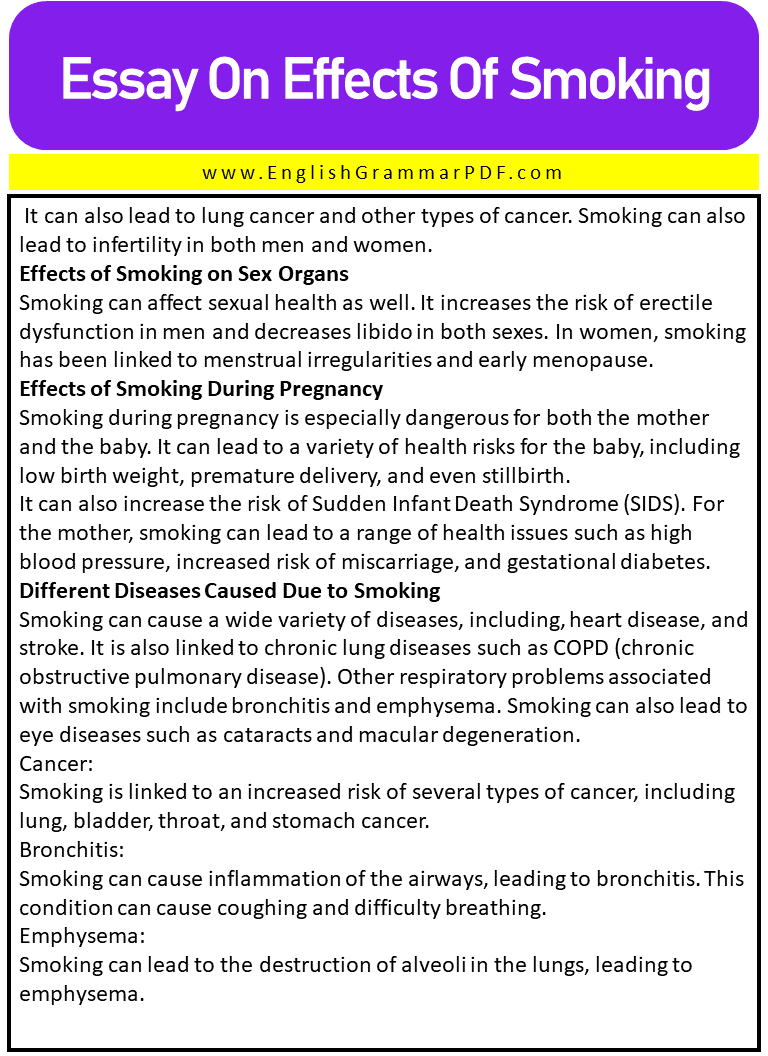Essay On Effects Of Smoking
Outline of essay:
- Introduction
- Harmful Effects of Smoking on the Body
- Effects of Smoking on Health
- Effects of Smoking on Sex Organs
- Effects of Smoking During Pregnancy
- Different Diseases Caused Due to Smoking
- Passive Smoking and Its Effects
- Effects of Smoking on Different Ages
- How to Quit Smoking
Introduction
Smoking has been a major health concern for decades now. It is one of the leading causes of preventable death and illness in the world. Smoking not only affects the smoker’s body but also those around them due to secondhand smoke. The effects of smoking can be severe and long-lasting, making it an important topic to be aware of.
Harmful Effects of Smoking on the Body
Smoking affects the body in numerous ways, some of which are irreversible. It can cause a decrease in lung function and respiratory problems such as asthma and bronchitis. It also increases the risk of heart disease, stroke, cancer, and other serious health conditions. Smoking can also cause discoloration of the skin and fingernails, as well as wrinkles due to a lack of oxygen.
Effects of Smoking on Health
Smoking can have a serious impact on one’s health. It increases the risk for several diseases and can lead to shorter life expectancy. Smokers are at higher risk for stroke, heart attack, and COPD (chronic obstructive pulmonary disease). It can also lead to lung cancer and other types of cancer. Smoking can also lead to infertility in both men and women.
Effects of Smoking on Sex Organs
Smoking can affect sexual health as well. It increases the risk of erectile dysfunction in men and decreases libido in both sexes. In women, smoking has been linked to menstrual irregularities and early menopause.
Effects of Smoking During Pregnancy
Smoking during pregnancy is especially dangerous for both the mother and the baby. It can lead to a variety of health risks for the baby, including low birth weight, premature delivery, and even stillbirth.
It can also increase the risk of Sudden Infant Death Syndrome (SIDS). For the mother, smoking can lead to a range of health issues such as high blood pressure, increased risk of miscarriage, and gestational diabetes.
Different Diseases Caused Due to Smoking
Smoking can cause a wide variety of diseases, including, heart disease, and stroke. It is also linked to chronic lung diseases such as COPD (chronic obstructive pulmonary disease). Other respiratory problems associated with smoking include bronchitis and emphysema. Smoking can also lead to eye diseases such as cataracts and macular degeneration.
Cancer:
Smoking is linked to an increased risk of several types of cancer, including lung, bladder, throat, and stomach cancer.
Bronchitis:
Smoking can cause inflammation of the airways, leading to bronchitis. This condition can cause coughing and difficulty breathing.
Emphysema:
Smoking can lead to the destruction of alveoli in the lungs, leading to emphysema. This condition makes it harder to breathe and also increases your risk of infection.
Heart Disease:
Smoking increases the risk of coronary heart disease, which can lead to a heart attack. It also increases the risk of stroke and peripheral arterial disease.
COPD (chronic obstructive pulmonary disease):
COPD is a chronic lung disease caused by smoking. It can lead to shortness of breath, coughing up mucus, and wheezing.
Cataracts:
Cataracts are a common eye problem caused by smoking. They cause the lens of the eye to become cloudy, leading to vision problems.
Macular degeneration:
Macular degeneration is an age-related condition that causes vision loss, and smoking can increase the risk of developing it.
Passive Smoking and Its Effects
Passive smoking is the inhalation of second-hand smoke. This can be just as dangerous as smoking, and it increases the risk for health issues such as respiratory problems and heart disease. Passive smoking can also lead to asthma in children who are exposed to it.
Effects of Smoking on Different Ages
Smoking can have different effects at different ages. In children, it can lead to stunted growth and a decrease in lung function. In older adults, smoking can increase the risk of health problems such as heart disease and stroke. It can also accelerate the aging process, leading to wrinkles and sagging skin due to a lack of oxygen.
How to Quit Smoking
The best way to reduce the risk of smoking-related diseases is to quit. Quitting can be difficult, but it’s possible with the right support and resources. Talk to your doctor about ways to quit, such as medications or counseling. Many support groups can help you stay motivated and on track.
FAQ’s
What happens to your body after smoking?
Smoking can lead to a range of health issues, such as heart disease, stroke, cancer, COPD, and other respiratory problems. It can also cause vision issues such as cataracts and macular degeneration.
How can I be a healthy smoker?
Unfortunately, there is no such thing as a “healthy smoker.” The only way to reduce the risk of smoking-related diseases is to quit.
Can lungs recover from smoking?
Yes, the lungs can recover from smoking. However, this process takes time and will vary depending on how long you’ve been smoking. The best way to ensure your lungs heal is to quit smoking as soon as possible.
What are the causes of smoking addiction?
Smoking addiction is caused by nicotine, which is a highly addictive substance. Other factors that can lead to smoking addiction are stress, peer pressure, genetic predisposition, health issues such as depression, and age.
Download the Pdf of the Essay On Effects Of Smoking





Read More Essays:


